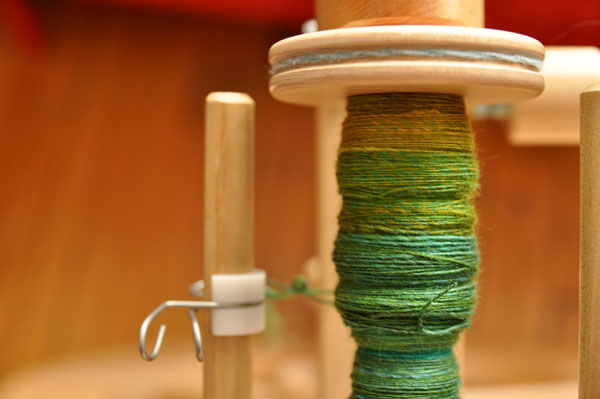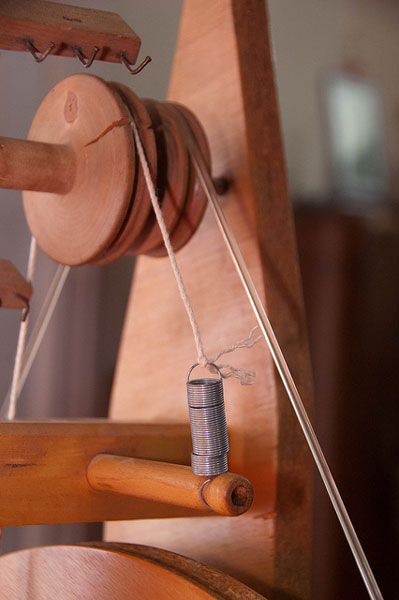Single drive spinning wheels have a drive band that loops once around the drive wheel and then once on the flyer or bobbin that works to add twist to your fiber. To allow the spun yarn to wind onto the bobbin, single drive wheels can have either a Scotch or Irish tension system. Most beginner spinners find that the Scotch tension system is easy to understand and adjust, allowing you to spin a variety of yarns on the same spinning wheel with only a few adjustments.

Photo via Laura Chau
What is Scotch tension?
Scotch tension brake systems are found on flyer-lead wheels, where the drive band loops around a pulley on the flyer, causing it to spin while treadling. The bobbin is held still by the brake band while the flyer rotates around it, allowing the yarn to wind onto the bobbin. An anchor or hook on one side of the bobbin holds the brake band over the groove in the bobbin, and a knob or peg allows you to adjust the tension on the band. The brake band needs a bit of elasticity or give to it, which can come in the form of a metal spring or rubber band attached to a non-elastic string. Since the drive band and brake band work separately, it’s easy to fine-tune your wheel depending on the type of yarn you want to spin.
Adjusting brake tension

Photo licensed via Creative Commons via Flickr user Steph
Try loosening your brake tension all the way, then slowly increase the tension as you spin. You’ll see that the higher the tension on the brake, the more the wheel will want to pull the fiber out of your hands! This is called the take-up. You can use adjustments on your brake band to help you spin a variety of yarns.
For high-twist, thin yarns, like sock yarn, you’ll want to loosen the brake tension. The bobbin will pull less, giving you time to draft nice and thin, and allowing lots of twist into your yarn. Looser brake tension is also useful for spinning delicate lace yarns.
When you’re spinning thicker yarns, increase the brake tension. The brake band will hold the bobbin more securely, and the bobbin will take up the yarn more quickly. This results in a thicker yarn with less twist.
Either way, as the bobbin fills up and becomes heavier, you’ll probably find that you need to adjust your tension one way or the other. Pay attention to how your drafting feels. If you find that your wheel is pulling the yarn so quickly that you can’t draft, loosen the brake tension. If your yarn isn’t winding on at all, you might need to increase the brake tension, or hold your fiber supply more gently.
What is Irish tension?

Photo via Louet
Bobbin-lead with Irish tension is another type of brake system for single drive wheels, most often seen on Louet spinning wheels. Instead of driving the flyer, the drive band sits in a whorl on the bobbin and the brake band is a wide leather strap that sits on the front of the flyer (Irish tension). When you slow down and release your tension on the spun yarn, the flyer slows but the bobbin continues to spin, allowing the yarn to wind on.
A side effect of the Irish tension system is that as you increase the tension on the brake band, more leg force is required to treadle and drive the bobbin. In general, bobbin-lead wheels pull in more forcefully than Scotch tension wheels, making them better suited to spinning thicker yarns.
Learn how to spin brilliant yarns that are to dye for in the Craftsy class Spinning Dyed Fibers with Felicia Lo. You’ll create both space-dyed and hand-painted fibers, with hues so beautiful and vibrant, the yarn will never see your stash!

Share tips, start a discussion or ask one of our experts or other students a question.
No Responses to “Understanding Scotch and Irish Tension”